Abstract
Ikeda, M., Ohtsuji, H., Imamura, T., and Komoike, Y. (1972).Brit. J. industr. Med.,29, 328-333. Urinary excretion of total trichloro-compounds, trichloroethanol, and trichloroacetic acid as a measure of exposure to trichloroethylene and tetrachloroethylene. To investigate the relation between trichloroethylene and tetrachloroethylene concentrations in working environments and metabolite concentrations in urine, a series of surveys was conducted at 17 workshops where the vapour concentration in the air of each workshop was relatively constant. Urine samples collected from 85 male workers were analysed for total trichloro-compounds (TTC), and trichloroacetic acid (TCA). Trichloroethanol (TCE) was estimated by difference. Statistical analyses of the data revealed that the urinary concentrations of both TTC and TCE were proportional to the atmospheric concentration of trichloroethylene. The concentration of TCA was also related to the vapour concentration up to 50 p.p.m. but not at higher concentrations. Further calculations suggested that only one-third of the trichloroethylene absorbed through the lungs was excreted in the urine during working time.
In tetrachloroethylene exposure, urinary metabolite levels increased until the atmospheric concentration of the solvent reached 50 to 100 p.p.m., but little increase occurred at higher concentration. This observation was further confirmed by experimental exposure of rats. The toxicological significance of changes in the metabolism of the two solvents is discussed in relation to the possible necessity of reducing the threshold limit value from the current value of 100 p.p.m.
Full text
PDF
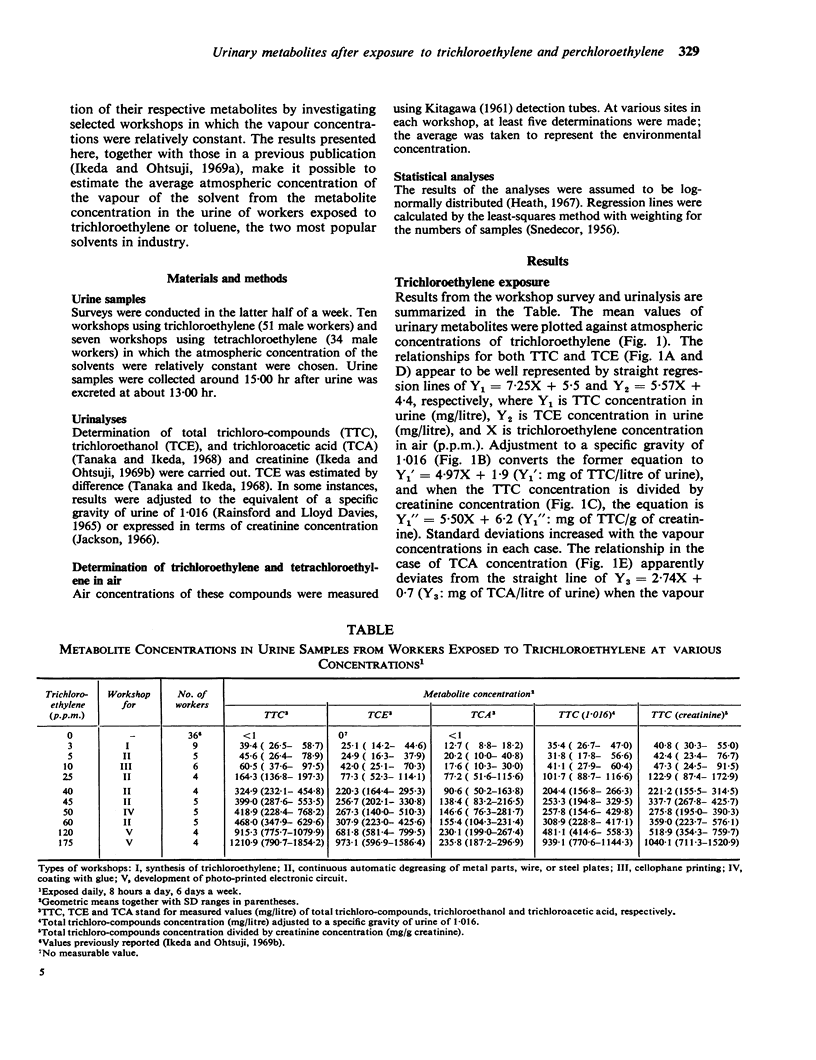
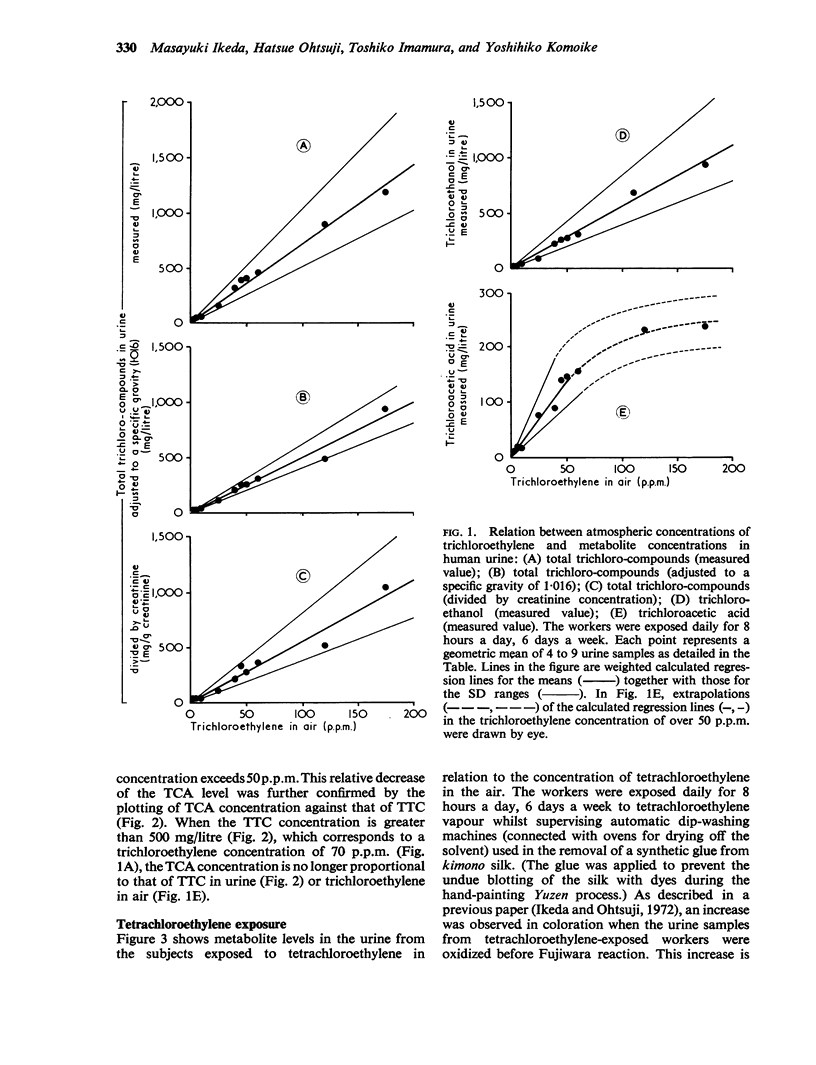
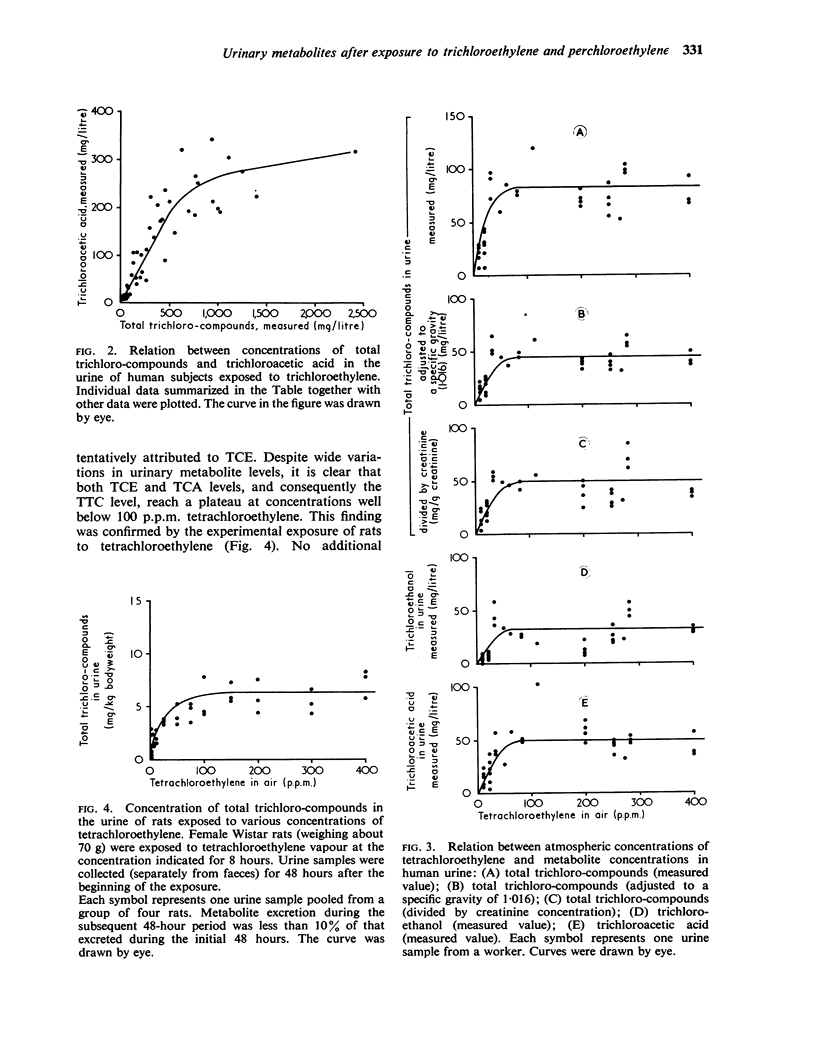
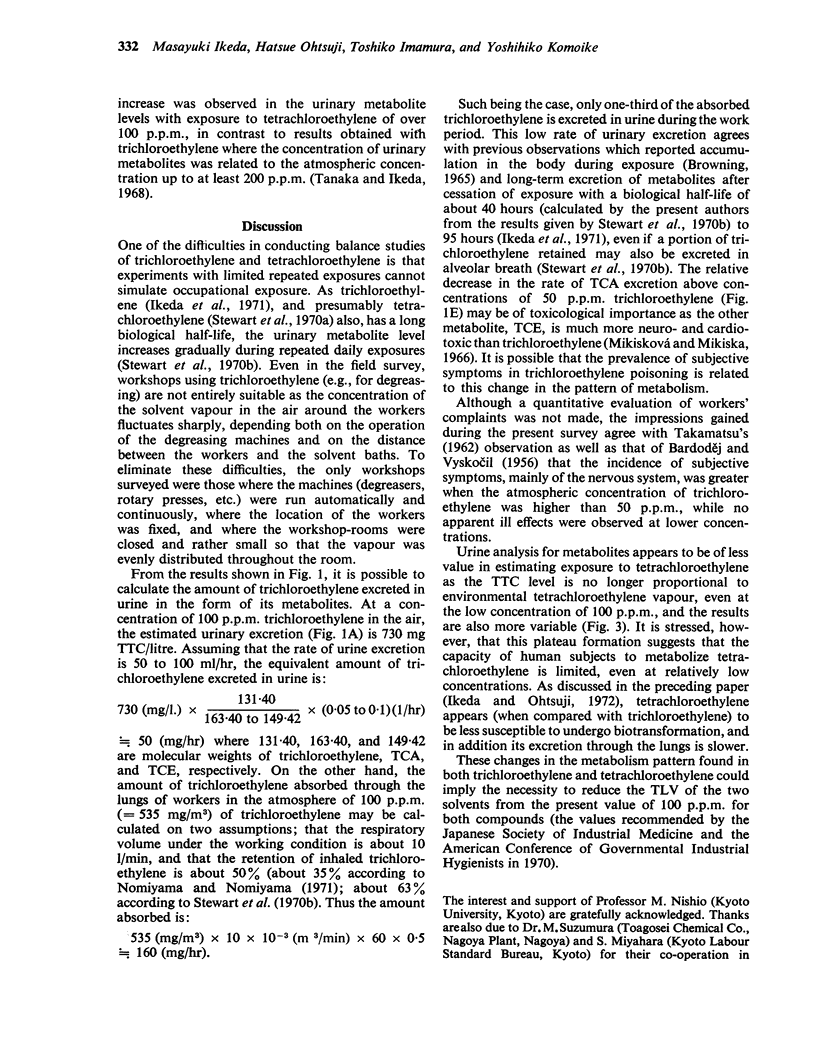
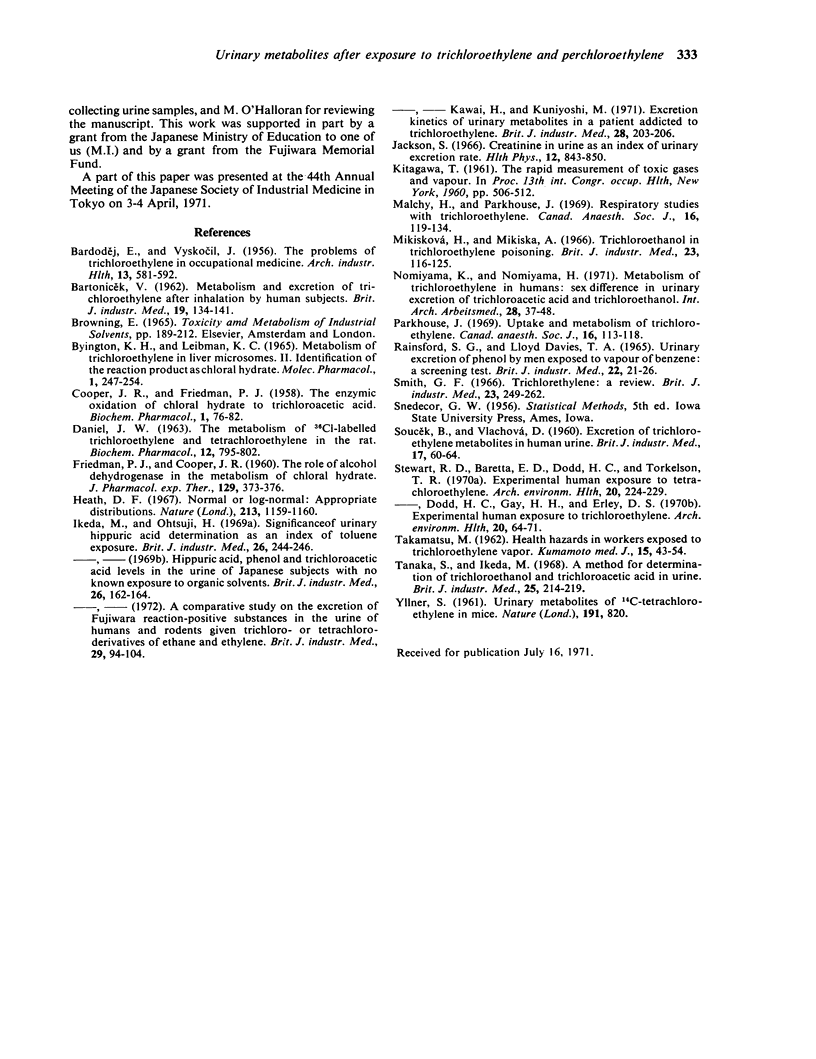
Selected References
These references are in PubMed. This may not be the complete list of references from this article.
- BARDODEJ Z., VYSKOCIL J. The problem of trichloroethylene in occupational medicine; trichloroethylene metabolism and its effect on the nervous system evaluated as a means of hygienic control. AMA Arch Ind Health. 1956 Jun;13(6):581–592. [PubMed] [Google Scholar]
- BARTONICEK V. Metabolism and excretion of trichloroethylene after inhalation by human subjects. Br J Ind Med. 1962 Apr;19:134–141. doi: 10.1136/oem.19.2.134. [DOI] [PMC free article] [PubMed] [Google Scholar]
- Byington K. H., Leibman K. C. Metabolism of trichloroethylene in liver microsomes. II. Identification of the reaction product as chloral hydrate. Mol Pharmacol. 1965 Nov;1(3):247–254. [PubMed] [Google Scholar]
- DANIEL J. W. THE METABOLISM OF 36C1-LABELLED TRICHLOROETHYLENE AND TETRACHLOROETHYLENE IN THE RAT. Biochem Pharmacol. 1963 Aug;12:795–802. doi: 10.1016/0006-2952(63)90109-6. [DOI] [PubMed] [Google Scholar]
- FRIEDMAN P. J., COOPER J. R. The role of alcohol dehydrogenase in the metabolism of chloral hydrate. J Pharmacol Exp Ther. 1960 Aug;129:373–376. [PubMed] [Google Scholar]
- Ikeda M., Ohtsuji H. Significance of urinary hippuric acid determination as an index of toluene exposure. Br J Ind Med. 1969 Jul;26(3):244–246. doi: 10.1136/oem.26.3.244. [DOI] [PMC free article] [PubMed] [Google Scholar]
- Ikeda M., Otsuji H., Kawai H., Kuniyoshi M. Excretion kinetics of urinary metabolites in a patient addicted to richloroethylene. Br J Ind Med. 1971 Apr;28(2):203–206. doi: 10.1136/oem.28.2.203. [DOI] [PMC free article] [PubMed] [Google Scholar]
- Jackson S. Creatinine in urine as an index of urinary excretion rate. Health Phys. 1966 Jun;12(6):843–850. doi: 10.1097/00004032-196606000-00014. [DOI] [PubMed] [Google Scholar]
- Malchy H., Parkhouse J. Respiratory studies with trichloroethylene. Can Anaesth Soc J. 1969 Mar;16(2):119–134. doi: 10.1007/BF03005792. [DOI] [PubMed] [Google Scholar]
- Mikisková H., Mikiska A. Trichloroethanol in trichloroethylene poisoning. Br J Ind Med. 1966 Apr;23(2):116–125. doi: 10.1136/oem.23.2.116. [DOI] [PMC free article] [PubMed] [Google Scholar]
- Nomiyama K., Nomiyama H. Metabolism of trichloroethylene in human. Sex difference in urinary excretion of trichloroacetic acid and trichloroethanol. Int Arch Arbeitsmed. 1971;28(1):37–48. [PubMed] [Google Scholar]
- Parkhouse J. Uptake and metabolism of trichloroethylene. Can Anaesth Soc J. 1969 Mar;16(2):113–118. doi: 10.1007/BF03005791. [DOI] [PubMed] [Google Scholar]
- RAINSFORD S. G., DAVIES T. A. URINARY EXCRETION OF PHENOL BY MEN EXPOSED TO VAPOUR OF BENZENE: A SCREENING TEST. Br J Ind Med. 1965 Jan;22:21–26. doi: 10.1136/oem.22.1.21. [DOI] [PMC free article] [PubMed] [Google Scholar]
- SOUCEK B., VLACHOVA D. Excretion of trichloroethylene metabolites in human urine. Br J Ind Med. 1960 Jan;17:60–64. doi: 10.1136/oem.17.1.60. [DOI] [PMC free article] [PubMed] [Google Scholar]
- Stewart R. D., Baretta E. D., Dodd H. C., Torkelson T. R. Experimental human exposure to tetrachloroethylene. Arch Environ Health. 1970 Feb;20(2):225–229. doi: 10.1080/00039896.1970.10665579. [DOI] [PubMed] [Google Scholar]
- Stewart R. D., Dodd H. C., Gay H. H., Erley D. S. Experimental human exposure to trichloroethylene. Arch Environ Health. 1970 Jan;20(1):64–71. doi: 10.1080/00039896.1970.10665543. [DOI] [PubMed] [Google Scholar]
- Tanaka S., Ikeda M. A method for determination of trichloroethanol and trichloroacetic acid in urine. Br J Ind Med. 1968 Jul;25(3):214–219. doi: 10.1136/oem.25.3.214. [DOI] [PMC free article] [PubMed] [Google Scholar]
- YLLNER S. Urinary metabolites of 14C-tetrachloroethylene in mice. Nature. 1961 Aug 19;191:820–820. doi: 10.1038/191820a0. [DOI] [PubMed] [Google Scholar]


